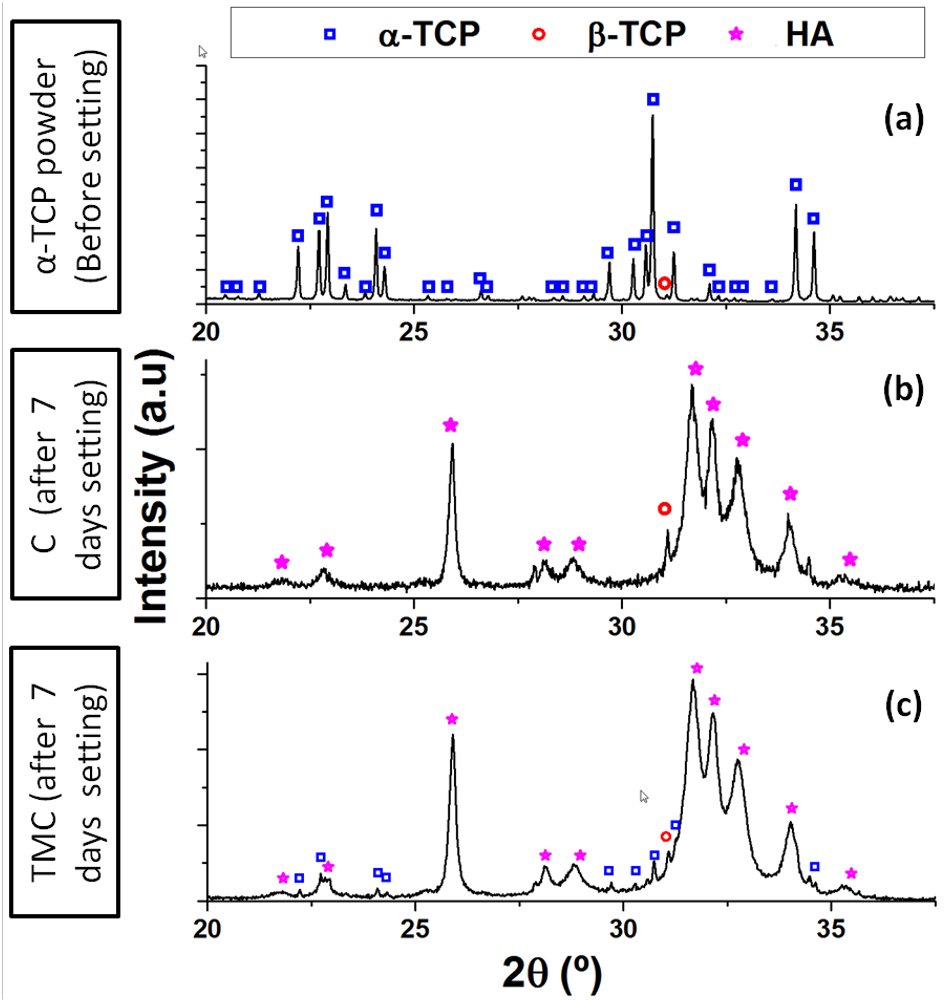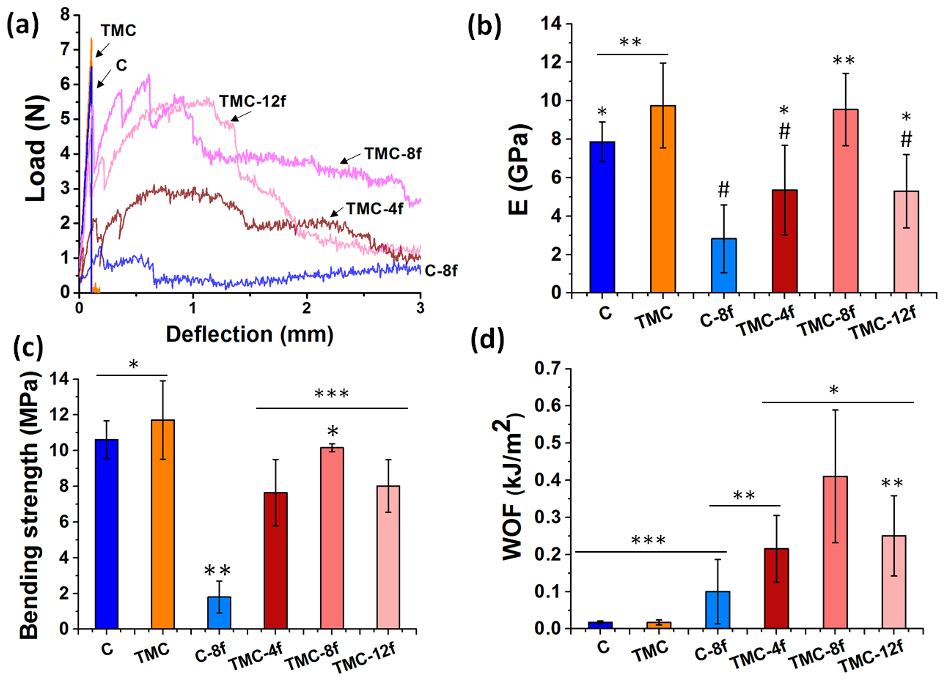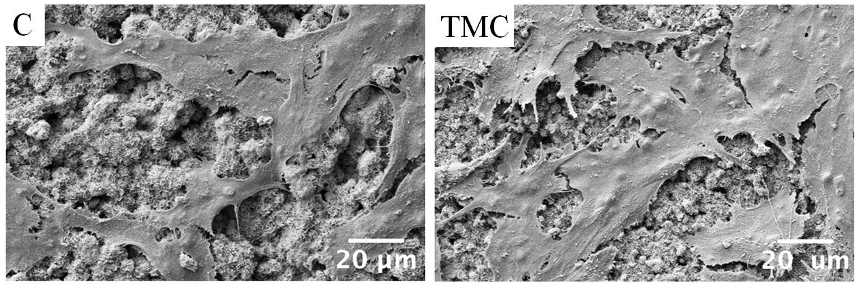A novel strategy to enhance interfacial adhesion in fiber-reinforced calcium phosphate cement
Reads0
Chats0
TLDR
The aim of the present work was to improve the interfacial adhesion between fibers and matrix to obtain tougher biocompatible fiber-reinforced calcium phosphate cements (FRCPCs), which resulted in an increase of the work of fracture (several hundred-fold increase), while the elastic modulus and bending strength were maintained similar to the materials without additives.Abstract:
Calcium phosphate cements (CPCs) are extensively used as synthetic bone grafts, but their poor toughness limits their use to non-load-bearing applications. Reinforcement through introduction of fibers and yarns has been evaluated in various studies but always resulted in a decrease in elastic modulus or bending strength when compared to the CPC matrix. The aim of the present work was to improve the interfacial adhesion between fibers and matrix to obtain tougher biocompatible fiber-reinforced calcium phosphate cements (FRCPCs). This was done by adding a polymer solution to the matrix, with chemical affinity to the reinforcing chitosan fibers, namely trimethyl chitosan (TMC). The improved wettability and chemical affinity of the chitosan fibers with the TMC in the liquid phase led to an enhancement of the interfacial adhesion. This resulted in an increase of the work of fracture (several hundred-fold increase), while the elastic modulus and bending strength were maintained similar to the materials without additives. Additionally the TMC-modified CPCs showed suitable biocompatibility with an osteoblastic cell line.read more
Figures

Figure 2. Crystalline phases determined by X-ray diffraction of a) initial powder α –TCP, b) sample C 7 days after setting, and c) sample TMC 7 days after setting. 
Figure 3. Mechanical properties under bending of unreinforced CPCs (C and TMC) and fiberreinforced CPCs (C-8f, TMC-4f, TMC-8f, TMC-12f): a) Typical load/deflection curves, b) Young’s modulus (E), c) bending strength, and d) work of fracture (WOF). Groups indicated with same symbol do not have statistically significant differences (p > 0.05). 
Figure 7. SEM images showing the morphology of cells cultured on C and TMC samples for 7 days. 
Figure 6. Live/dead images showing the alive cells (green) and the dead cells (red) on the C and TMC samples surface at different time points (bar = 100 μm) 
Figure 5. a) Number of cells adhered on the samples surface at different time points, and b) evolution with time of the pH of the cell culture medium (1 ml) in contact with a cement disc (15 mm diameter x 1.5 mm thickness). 
Table 3. Crystalline phases as determined by X-ray diffraction, and specific surface area measured by N2 adsorption of the initial powder and set cements.
Citations
More filters
Journal ArticleDOI
Bone biomaterials and interactions with stem cells.
TL;DR: A comprehensive review of the state of the art of bone biomaterials and their interactions with stem cells is presented and the promising seed stem cells for bone repair are summarized, and their interaction mechanisms are discussed in detail.
Journal ArticleDOI
Bioceramics and bone healing.
TL;DR: Advanced technologies open up new possibilities in the design of bioceramics for bone regeneration; 3D-printing technologies, in combination with the development of hybrid materials with enhanced mechanical properties, supported by finite element modelling tools are expected to enable the design and fabrication of mechanically competent patient-specific bone grafts.
Book ChapterDOI
Synthetic bone graft substitutes: Calcium-based biomaterials
TL;DR: In this paper, the main characteristics and the potential of synthetic bone graft substitutes based on calcium for dental applications are described, and the current and novel strategies based on ion doping, surface functionalization, and additive manufacturing are discussed.
Journal ArticleDOI
Reinforcement and Fatigue of a Bioinspired Mineral–Organic Bioresorbable Bone Adhesive
TL;DR: Biological and biomechanical performance of the fiber‐reinforced adhesive is evaluated in a rabbit distal femur osteotomy model, showing the potential of the bone adhesive for clinical use.
Journal ArticleDOI
Toward stronger robocast calcium phosphate scaffolds for bone tissue engineering: A mini-review and meta-analysis
TL;DR: In this article , the current state of knowledge and existing research on robocasting of calcium phosphate scaffolds are presented, and a meta-analysis from the published literature of the compressive strength of the robocast calcium-phosphate scaffolds is provided.
References
More filters
Journal ArticleDOI
Morphology and mechanical properties of chitosan fibers obtained by gel-spinning: Influence of the dry-jet-stretching step and ageing
TL;DR: The ageing in ambient atmosphere played an important role in the crystalline microstructure in relation to: the kinetics of ammonium acetate hydrolysis, the formation of a weak fraction of the anhydrous allomorph of chitosan, and an increase of the crystallinity index, whereas the Young's modulus was increased and the tenacity was slightly lowered.
Journal ArticleDOI
Self-Hardening Calcium Phosphate Cement-Mesh Composite: Reinforcement, Macropores, and Cell Response
Hockin H.K. Xu,Carl G. Simon +1 more
TL;DR: The new CPC-mesh formulation supported the adhesion, spreading, proliferation, and viability of osteoblast-like cells in vitro and may help extend the use of CPC to larger stress-bearing repairs, and the macropores may facilitate tissue ingrowth and integration of CPC with adjacent bone.
Journal ArticleDOI
Effects of fibre reinforcement on the mechanical properties of brushite cement.
N.J.S. Gorst,Yvonne Perrie,Uwe Gbureck,A.L. Hutton,M.P. Hofmann,Liam M. Grover,Jake E. Barralet +6 more
TL;DR: The results showed that, apart from the mechanical properties of the reinforcing material, the structure of the incorporated fibres, regular or random, is crucial for the resulting flexural strength and modulus of elasticity.
Journal ArticleDOI
Deformation Capacity and Shear Strength of Fiber-Reinforced Cement Composite Flexural Members Subjected to Displacement Reversals
TL;DR: In this article, the behavior of fiber-reinforced cement composite FRCC flexural members under large displacement reversals was evaluated and the displacement capacity and shear strength of members constructed with strain-hardening FRCC materials.
Journal ArticleDOI
Calcium Orthophosphate Cements and Concretes
TL;DR: In this paper, an insight into calcium orthophosphate cements and concretes, as excellent biomaterials suitable for both dental and bone grafting application, has been provided.
Related Papers (5)
Reinforcement Strategies for Load-Bearing Calcium Phosphate Biocements
Fiber reinforced calcium phosphate cements -- on the way to degradable load bearing bone substitutes?
Reinhard Krüger,Jürgen Groll +1 more